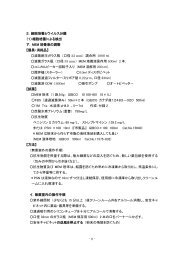Program and Abstracts(PDF)
Program and Abstracts(PDF)
Program and Abstracts(PDF)
Create successful ePaper yourself
Turn your PDF publications into a flip-book with our unique Google optimized e-Paper software.
Kitadai, Y., <strong>and</strong> S. Kadowaki. 2004. The growth <strong>and</strong> N, P uptake rates of Ulva pertusa cultured<br />
in coastal fish farms. Suisanzoshoku, Vol:52. Pp 65–72. (in Japanese with English abstract)<br />
Biological water purification by culturing Ulva pertusa in coastal fish farms was estimated as a<br />
function of light intensity, dissolved inorganic nutrient <strong>and</strong> water temperature. Ulva pertusa was<br />
cultured from 0.5 m to 8 m depths in coastal fish farms from August to November, 2002. The<br />
maximum growth of thallus area, wet weight <strong>and</strong> thickness were recorded at 0.5 m depth. The<br />
maximum growth of thallus area reached to 640 cm 2 on August. The maximum growth of thallus<br />
thickness reached to 0.11 mm on November. Average contents of total nitrogen (N) <strong>and</strong> total<br />
phosphorus (P) in Ulva pertusa reached to 35 mg N/g dry <strong>and</strong> 2.1 mg P/g dry in October,<br />
respectively. The maximum N, P uptake rates of Ulva pertusa were 3.6 mg N/m 2 /day <strong>and</strong> 0.19<br />
mg P/m 2 /day at 0.5 m depth, respectively. Michaelis-Menten’s constants of N, P uptake rates<br />
were 26 μg N/l <strong>and</strong> 8.6 μg P/l, respectively. Downward irradiance of 730 μmol/m 2 /s resulted in<br />
the maximum N, P uptake rates. N, P uptake rates of Ulva pertusa at 25°C were 2.5 mg N 2 /day<br />
<strong>and</strong> 0.13 mg P/m 2 /day, respectively. Water temperature coefficients of N, P uptake rates were<br />
1.076 <strong>and</strong> 1.084, respectively. The N <strong>and</strong> P uptake rates of cultured Ulva pertusa were<br />
formulated from dissolved inorganic nutrients, light intensity <strong>and</strong> water temperature<br />
characteristics found in coastal fish farms, <strong>and</strong> the calculated values corresponded well with the<br />
observed values.<br />
Hiraoka, M., S. Shimada, M. Uenosono, <strong>and</strong> M. Masuda. 2004. A new green-tide-forming alga,<br />
Ulva ohnoi Hiraoka et Shimada sp. nov. (Ulvales, Ulvophyceae) from Japan. Phycological<br />
Research, Vol:52. Pp 17–29.<br />
Ulva ohnoi Hiraoka et Shimada sp. nov. (Ulvales, Ulvophyceae) is described from southern <strong>and</strong><br />
western Japan <strong>and</strong> is characterized by the following combination of features: (i) the large, fragile,<br />
easily torn thalli, which are 30-55 μm thick in the upper <strong>and</strong> middle regions <strong>and</strong> often have<br />
microscopic marginal teeth; (ii) the production of zoids in the upper marginal region; (iii) a<br />
regular alternation of dioecious gametophytes <strong>and</strong> a sporophyte; (iv) the production of freefloating<br />
thalli from torn-off attached thalli, which reproduce vegetatively by fragmentation <strong>and</strong><br />
form green tides in summer to autumn; (V) disorderly arranged cells that are polygonal or<br />
quadrangular in the upper <strong>and</strong> middle regions; <strong>and</strong> (vi) the chloroplast covering the outer face of<br />
cell, with 1-3 pyrenoids. Ulva ohnoi differs from U. armoricana Dion et al., U. fasciata Delile, U.<br />
reticulata Forsskål, U. sc<strong>and</strong>inavica Bliding <strong>and</strong> U. spinulosa Okamura et Segawa, which all<br />
possess microscopic marginal serrations, in thallus shape, cell shape or life history pattern. It is<br />
also distinguished from morphologically similar species by sequences of the nuclear encoded<br />
internal transcribed spacers <strong>and</strong> the 5.85 ribosomal RNA gene <strong>and</strong> the plastid encoded large<br />
subunit of ribulose-1,5-bisphosphate carboxylase/oxgenase gene. Furthermore, crossing tests<br />
demonstrate that there is a reproductive boundary between U. ohnoi <strong>and</strong> the most closely related<br />
species, U. fasciata <strong>and</strong> U. reticulata.<br />
Yokoyama, H. 2010. Monitoring, assessment <strong>and</strong> management of fish farm environments in<br />
Japan. Reviews in Aquaculture, Vol:2. Pp 1–12.<br />
In Japan, coastal fish farming has become a well-established industry. Intensive cultivation of<br />
finfish, however, generates large amounts of organic waste <strong>and</strong> nutrients, resulting in<br />
37



